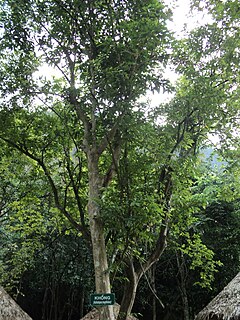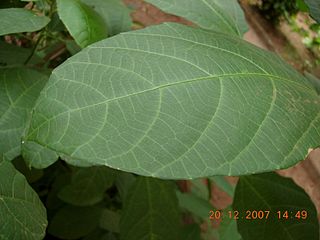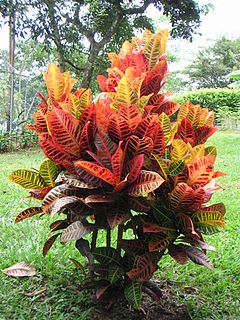| Cheilosa montana | |
|---|---|
| Scientific classification | |
| Kingdom: | Plantae |
| (unranked): | Angiosperms |
| (unranked): | Eudicots |
| (unranked): | Rosids |
| Order: | Malpighiales |
| Family: | Euphorbiaceae |
| Subfamily: | Acalyphoideae |
| Tribe: | Cheiloseae |
| Genus: | Cheilosa Blume |
| Species: | C. montana |
| Binomial name | |
| Cheilosa montana Blume | |
| Synonyms [1] | |
| |
Cheilosa is a monotypic plant genus of the family Euphorbiaceae first described as a genus in 1826. [2] [3] Only one species is recognized: Cheilosa montana, native to Southeast Asia (Peninsular Malaysia, Borneo, Sumatra, Philippines, Java). [1] [4]

Plants are mainly multicellular, predominantly photosynthetic eukaryotes of the kingdom Plantae. Historically, plants were treated as one of two kingdoms including all living things that were not animals, and all algae and fungi were treated as plants. However, all current definitions of Plantae exclude the fungi and some algae, as well as the prokaryotes. By one definition, plants form the clade Viridiplantae, a group that includes the flowering plants, conifers and other gymnosperms, ferns and their allies, hornworts, liverworts, mosses and the green algae, but excludes the red and brown algae.
Family is one of the eight major hierarchical taxonomic ranks in Linnaean taxonomy; it is classified between order and genus. A family may be divided into subfamilies, which are intermediate ranks between the ranks of family and genus. The official family names are Latin in origin; however, popular names are often used: for example, walnut trees and hickory trees belong to the family Juglandaceae, but that family is commonly referred to as being the "walnut family".

The Euphorbiaceae, the spurge family, is a large family of flowering plants. In common English, they are sometimes called euphorbias, which is also the name of a genus in the family. Most spurges such as Euphorbia paralias are herbs, but some, especially in the tropics, are shrubs or trees, such as Hevea brasiliensis. Some, such as Euphorbia canariensis, are succulent and resemble cacti because of convergent evolution. This family occurs mainly in the tropics, with the majority of the species in the Indo-Malayan region and tropical America a strong second. A large variety occurs in tropical Africa, but they are not as abundant or varied as in the two other tropical regions. However, Euphorbiaceae also has many species in nontropical areas such as the Mediterranean Basin, the Middle East, South Africa, and the southern United States.
- formerly included
moved to Trigonostemon
- Cheilosa whiteanaCroizat, synonym of Trigonostemon whiteanus (Croizat) Airy Shaw







